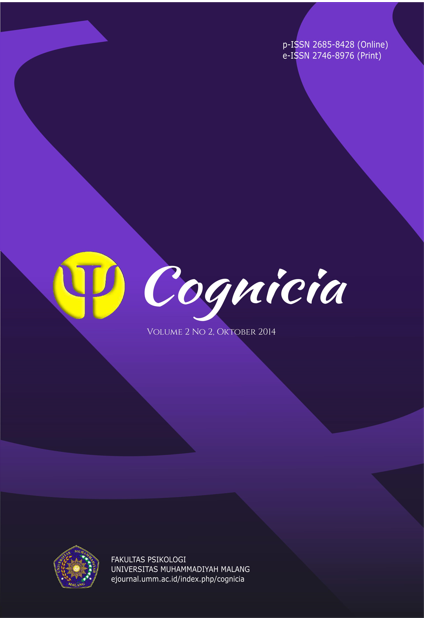SELF CONTROL DENGAN PROKRASTINASI PADA MAHASISWA DALAM MENYELESAIKAN TUGAS PERKULIAHAN
DOI:
https://doi.org/10.22219/cognicia.v2i2.2016Abstract
Perilaku prokrastinasi merupakan kecenderungan menunda dan menghindari suatu tugas yang dilakukan secara berulang-ulang dan dalam keadaan sadar yang dilakukan oleh seseorang karena kurang adanya kontrol diri, akibatnya banyak tugas yang terbengkalai dan tidak terselesaikan secara maksimal hingga tak jarang berakibat pada tertundanya perolehan gelar kesarjanaan. Tujuan penelitian ini adalah untuk mengetahui hubungan antara self control dengan perilaku prokrastinasi pada mahasiswa. Subjek penelitian ini adalah mahasiswa Fakultas Psikologi Universitas Muhammadiyah Malang berjumlah 243 mahasiswa. Teknik pengambilan sampel dalam penelitian ini menggunakan teknik purposive sample yang diambil diambil dengan teknik non random sampling. Penelitian ini menggunakan skala Self Control dan Tuckman Procrastination Scale (TPS). Teknik analisis data yang digunakan adalah analisis korelasi product moment. Hasil penelitian ini menunjukkan adanya hubungan negatif yang signifikan (r = -0,625;sig= 0,000 < 0,01) antara tingkat Self control dengan perilaku prokrastinasi pada mahasiswa dalam menyelesaikan tugas perkuliahan. Semakin tinggi self control pada mahasiswa, maka semakin rendah perilaku prokrastinasi. sebaliknya semakin rendah self control yang ada pada diri mahasiswa, maka semakin tinggi pula perilaku prokrastinasi. Sumbangan efektif dari penelitian ini sebesar 39,0%.
Kata kunci: Self control, perilaku prokrastinasi
Procrastination behavior has been understood as one’s inclination to postpone and probably even avoid one’s assignments repeatedly. The consequences were clear as the assignments were neglected and not succesfully accomplished. The worst consequences for university students especially was their graduation might be achieved much later than usual. This study aimed to find any correlation between self control and procrastionation behavior among university students. The subjects were 243 students of Department of Psychology of the University of Muhammadiyah Malang. They were non-randomly recruited by purposive sampling technique. Self Control Scale and Tuckman Procrastination Scale (TPS) were used to obtain data, which then were analyzed by using product moment correlation analysis technique. The findings revealed that there was a significant negative correlation (r= -0.625; sig= 0.000 < 0.01) between the level of self control and procrastination behavior among the subjects. The higher the university students’ self control, the lower their inclination for procrastination behavior.
Keywords: Self control, procrastination behavior
Downloads
Downloads
Published
How to Cite
Issue
Section
License
Copyright (c) 1970 Mellysha Mugista A

This work is licensed under a Creative Commons Attribution-ShareAlike 4.0 International License.
Authors who publish with Jurnal Cognicia agree to the following terms:
- For all articles published in Jurnal Cognicia, copyright is retained by the authors. Authors give permission to the publisher to announce the work with conditions. When the manuscript is accepted for publication, the authors agree to automatic transfer of the publishing right to the publisher.
- Authors retain copyright and grant the journal right of first publication with the work simultaneously licensed under a Creative Commons Attribution-ShareAlike 4.0 International License that allows others to share the work with an acknowledgment of the work's authorship and initial publication in this journal.
- Authors are able to enter into separate, additional contractual arrangements for the non-exclusive distribution of the journal's published version of the work (e.g., post it to an institutional repository or publish it in a book), with an acknowledgment of its initial publication in this journal.
- Authors are permitted and encouraged to post their work online (e.g., in institutional repositories or on their website) prior to and during the submission process, as it can lead to productive exchanges, as well as earlier and greater citation of published wor (See The Effect of Open Access).

This work is licensed under a Creative Commons Attribution-ShareAlike 4.0 International License







